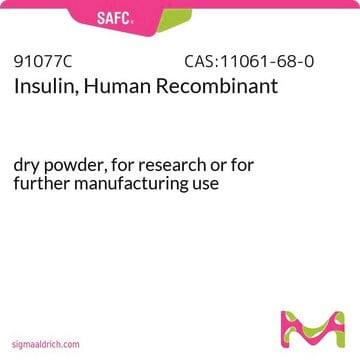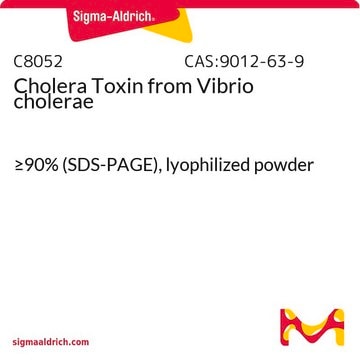I0516
Insulin solution from bovine pancreas
10 mg/mL insulin in 25 mM HEPES, pH 8.2, BioReagent, sterile-filtered, suitable for cell culture
Sinónimos:
Bovine insulin, Cell culture grade insulin
About This Item
Productos recomendados
origen biológico
bovine
esterilidad
sterile-filtered
Línea del producto
BioReagent
Formulario
solution
concentración
10 mg/mL insulin in 25 mM HEPES, pH 8.2
técnicas
cell culture | mammalian: suitable
single cell analysis: suitable
impurezas
endotoxin, tested
pH
7.9-8.5
Nº de acceso UniProt
Condiciones de envío
ambient
temp. de almacenamiento
2-8°C
cadena SMILES
SC[C@H](NC(=O)[C@@H](NC(=O)[C@@H](NC(=O)[C@@H](NC(=O)[C@@H](NC(=O)[C@@H](NC(=O)CN)[C@H](CC)C)C(C)C)CCC(=O)O)CCC(=O)N)CS)C(=O)N[C@@H](C)C(=O)N[C@@H](CO)C(=O)N[C@@H](C(C)C)C(=O)N[C@@H](CS)C(=O)N[C@@H](CO)C(=O)N[C@@H](CC(C)C)C(=O)N[C@@H](Cc4ccc(cc4)O)C(=O)N[
InChI
1S/2C97H151N25O34S4/c2*1-12-46(10)77(120-72(131)35-98)96(154)122-76(45(8)9)94(152)107-55(24-28-74(134)135)79(137)104-53(22-26-69(100)128)82(140)116-66(40-159)93(151)118-64(38-157)90(148)103-47(11)78(136)114-63(37-124)89(147)121-75(44(6)7)95(153)119-67(41-160)92(150)115-62(36-123)88(146)109-57(30-43(4)5)84(142)110-58(31-48-13-17-50(125)18-14-48)85(143)105-52(21-25-68(99)127)80(138)108-56(29-42(2)3)83(141)106-54(23-27-73(132)133)81(139)112-60(33-70(101)129)87(145)111-59(32-49-15-19-51(126)20-16-49)86(144)117-65(39-158)91(149)113-61(97(155)156)34-71(102)130/h2*13-20,42-47,52-67,75-77,123-126,157-160H,12,21-41,98H2,1-11H3,(H2,99,127)(H2,100,128)(H2,101,129)(H2,102,130)(H,103,148)(H,104,137)(H,105,143)(H,106,141)(H,107,152)(H,108,138)(H,109,146)(H,110,142)(H,111,145)(H,112,139)(H,113,149)(H,114,136)(H,115,150)(H,116,140)(H,117,144)(H,118,151)(H,119,153)(H,120,131)(H,121,147)(H,122,154)(H,132,133)(H,134,135)(H,155,156)/t2*46-,47-,52-,53-,54-,55-,56-,57-,58-,59-,60-,61-,62-,63-,64-,65-,66-,67-,75-,76-,77-/m00/s1
Clave InChI
XYPANFGXFLOTDK-CJLNJPJHSA-N
Información sobre el gen
bovine ... INS(280829)
cow ... INS(280829)
Aplicación
- to study the effect of exogenous insulin on plasma concentrations of glucose, insulin, insulin-like growth factor I (IGF-I), and progesterone (P4) in pubertal beef heifers
- to study the insulin responsiveness of the placenta during pregnancy complications using primary human trophoblast cells and placental villous explants
- to study the effect of insulin receptor signaling dendritic spine density in neonatal mouse hippocampal neurons in vitro
Acciones bioquímicas o fisiológicas
Forma física
Producto relacionado
Código de clase de almacenamiento
12 - Non Combustible Liquids
Clase de riesgo para el agua (WGK)
WGK 2
Punto de inflamabilidad (°F)
Not applicable
Punto de inflamabilidad (°C)
Not applicable
Equipo de protección personal
Eyeshields, Gloves
Elija entre una de las versiones más recientes:
Certificados de análisis (COA)
¿No ve la versión correcta?
Si necesita una versión concreta, puede buscar un certificado específico por el número de lote.
¿Ya tiene este producto?
Encuentre la documentación para los productos que ha comprado recientemente en la Biblioteca de documentos.
Los clientes también vieron
Nuestro equipo de científicos tiene experiencia en todas las áreas de investigación: Ciencias de la vida, Ciencia de los materiales, Síntesis química, Cromatografía, Analítica y muchas otras.
Póngase en contacto con el Servicio técnico












